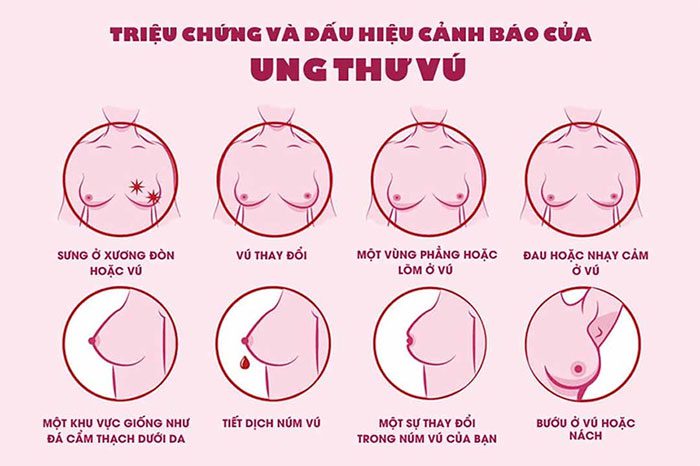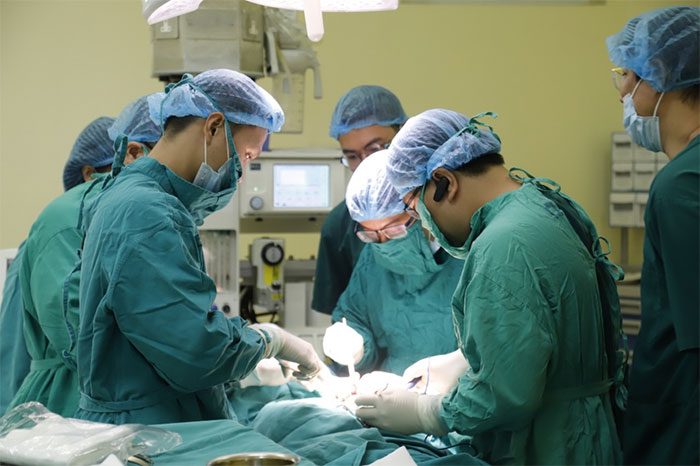Breast cancer is one of the most common malignancies among women worldwide and in Vietnam. In Vietnam, a notable difference compared to the rest of the world is the trend of younger patients.
According to Associate Professor Dr. Le Hong Quang, Head of the Breast Surgery Department at K Hospital in Hanoi, compared to Western countries, the highest rate of breast cancer among women occurs in those aged 55-60 and older. However, in our country, many cases are seen in women in their 40s.

Breast cancer is one of the most common malignancies among women worldwide and in Vietnam. (Photo: Vantagenews).
“In our professional practice, we have even encountered cases of breast cancer in women in their early 20s. In Vietnam, according to the Global Cancer Observatory (GLOBOCAN 2020), breast cancer is the most frequently diagnosed cancer with 21,555 new cases, accounting for nearly 25.8% of all cancer cases,” stated Associate Professor Dr. Le Hong Quang.
Warning Symptoms
Associate Professor Dr. Le Hong Quang mentioned that breast cancer typically presents with the symptom of a lump in the breast tissue. Usually, newly appearing lumps are painless, which can lead patients to underestimate their condition. The tumor often develops silently, gradually increasing in size over time, causing patients to seek medical advice only when it reaches a certain size.
Additionally, symptoms may include swollen lymph nodes in the armpit, ulceration of the nipple, or discharge.
Today, with the expansion of screening programs for early detection, many cases of breast cancer can be identified even before a lump appears.
“Women over 40 can take better care of their health by participating in screening programs for early detection of cancer, which helps increase treatment success rates and improves treatment quality,” Dr. Quang advised.

Breast cancer typically presents with the symptom of a lump in the breast tissue. (Photo: BVCC).
According to this expert, young adolescents may also start to develop fibrocystic breast changes. For breast cancer, the incidence is typically higher in those aged 40-55.
The causes and risk factors for breast cancer are quite varied.
- Age: As the body ages, the ability to repair mutations and damage decreases, leading to cancer development.
- Genetics: If a woman’s mother, sisters, or aunts have had breast cancer, she is at a significantly higher risk.
- Hormonal factors: Women who marry or give birth later, or who do not have children, also face a higher risk of breast cancer.
- Additionally, other risk factors such as adopting a Western lifestyle and low physical activity have been recorded as increasing breast cancer rates.
- Women past menopause who have been on hormone replacement therapy for extended periods should also be aware of early detection measures for cancer.
According to Associate Professor Dr. Le Hong Quang, it is currently recommended that women aged 40 and older in Vietnam undergo screening for early detection of breast cancer. Those with a family history of high risk should proactively seek earlier screenings.
Patients Should Trust Science
“With the current trend of using traditional medicines for topical applications or non-scientific methods that have not been proven, we advise patients to abandon these thoughts immediately. You should only trust conventional treatment methods.“, he emphasized.
The Head of the Breast Surgery Department at K Hospital believes that over the past two to three decades, there have been significant advancements in surgery, chemotherapy, radiation therapy, hormonal treatment, and targeted therapy for breast cancer, drastically changing treatment perspectives compared to the past.
Regarding nutrition, breast cancer patients should follow a diet similar to that of cancer patients in general. A healthy, balanced diet without excessive restrictions on certain foods is recommended. Specifically for breast cancer patients with hormone receptor-positive cases, weight management is crucial to avoid obesity. Fat metabolism can create unfavorable factors in treatment.

Doctors at K Hospital perform surgery on patients. (Photo: BVCC).
According to Associate Professor Le Hong Quang, breast cancer treatment is a prime example of multimodal cancer treatment, where physicians seamlessly combine surgery, radiation therapy, and systemic treatments (chemotherapy, targeted therapy).
The choice of methods and timing is determined by a specialized medical team based on the specific conditions of each patient.
In terms of breast cancer surgery, in previous decades, patients who presented at advanced stages often had to undergo total mastectomy due to the lack of scientific advancement. However, recently, with significant scientific progress in breast cancer treatment, patients diagnosed at earlier stages may be candidates for breast-conserving surgery. They can still treat their cancer effectively while preserving their breast tissue.
“This is very important, as in modern society, especially for younger women or those with active social lives, the need for body image and social interaction significantly impacts the psychological well-being of patients. Maintaining patients’ quality of life is also a crucial goal alongside curing the disease,” the expert analyzed.
In addition to breast-conserving surgical methods, for cases where conservation is not indicated or where mastectomy has occurred, doctors also develop breast reconstruction surgery for women. This area of surgery has seen many advancements recently, greatly benefiting women by restoring confidence and improving quality of life.


















































